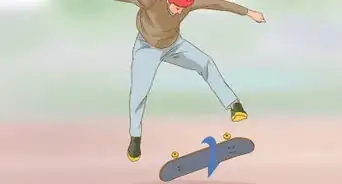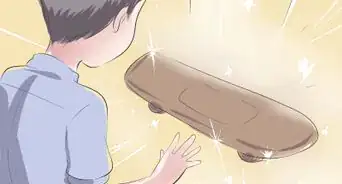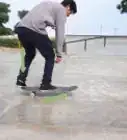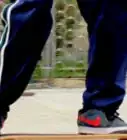This article was co-authored by Jon Depoian. Jon Depoian is a Skateboarding Instructor and the Owner of Intro2Skateboarding, an organization based in Orange County, California that provides professional private, home-school, after-school, birthday party, and summer camp skateboard lessons for beginners and experienced skateboarders alike. Jon has over 21 years of skateboarding experience and over 10 years of skateboard instruction experience. He also has extensive experience producing street skateboarding videos and skating competitions.
There are 7 references cited in this article, which can be found at the bottom of the page.
This article has been viewed 143,493 times.
The ollie is the most basic and fundamental aerial skateboarding trick, but that doesn't mean that it's easy. If you want to develop your skate trick skills, the ollie is absolutely essential. Whether you're well-rehearsed at the stationary ollie and you want to learn to do it in motion, or you're starting from scratch, you can learn the basic process involved, and how to develop the skills you'll need to pull it off.
Steps
Working Up to an Ollie
-
1Work on your foot placement. When you're riding properly, your front foot should be just behind the front truck screws, and your back foot should be on the back tail. This foot positioning offers the most stability and safety.[1]
- Popping the board up in the air is actually the easiest part of the ollie. Before you try to ollie while moving, make sure you're riding properly and using smooth, even foot placement at all times when you skate.
-
2Practice riding smoothly. Doing a stationary ollie is sometimes actually a lot easier than learning to ride a skateboard comfortably at speed, without doing much at all. Depending on the board you're using and your sense of balance, it's important to devote a considerable amount of time to just getting comfortable on the board, riding, turning, and stopping without falling down.[2]
- Check out this article for more tips about starting out and riding comfortably.
Advertisement -
3Learn to fall properly. When you fall, it's important to use your wrist pads to brace yourself, protecting yourself with your hands and your arms to protect your head as much as possible. If you feel the board slipping, bail out and take a bump on your butt or your hands at the expense of your head.[3]
- Only skate in safe and designated areas for skating to be safe, and try to scout for pebbles and cracks that'll mess you up while you're skating.
- Always use proper safety equipment when you're skateboarding, and especially when you're attempting to ollie in motion. Never skateboard without wearing a helmet.
- Even the best skaters are going to fall on a regular basis. No shame. Learn to fall properly and pick yourself back up.
Practicing Ollies on the Ground
-
1Find a level area of ground to practice on. While it may seem safer to try on grass, it's pretty hard to actually ollie on grass, so just look for a smooth, flat, even slab of concrete. This will be a lot safer and yield better results than other surfaces.
- Make sure everything is even and that you've got enough open space to do an ollie safely.
- Always practice ollies on the ground first before trying them in motion. When you can stick ten consecutive ollies while stationary, then it's time to move on to an ollie in motion.
-
2Practice popping the board back. While standing still, practice flexing your knees slightly to lower your center of gravity, and staying level. Then practice staying on the board while you pop the tail back. Do this a few times, staying even and level.[4]
- Stand next to the board and use your back foot to pop the tail down, as well, as you would in an ollie. Feel how much pressure is required to do it. Try doing 10-15 of these, or as many as it takes to get you to do it without thinking about it.
- A common beginner mistake is to push down too hard on the tail, which prevents your board from going up in the air. You should be doing more of a light-footed flick down with your ankle that bounces the board off the ground.[5]
-
3Try jumping slightly while you pop it. When you're comfortable popping, pop the tail down and jump slightly. It's kind of hard to describe, because you should be doing it all in one smooth motion, moving your front foot forward to control the board as you pop it with your back foot. With some practice, you should get a basic ollie down.[6]
- When your tail pops off the ground, then you should slide your front foot up so the rest of your board can come up too.[7]
- If you need to bail out, bail out. You're just practicing. Try to land it if you can, but just try getting the board to pop at first.
-
4Try a full-on ollie. Snap the tail back and jump, pushing the board back level and landing on it. Keep practicing this basic motion, trying to get your stand-still ollie as high as you can, while maintaining stability and control of the board. Don't try to do it in motion until you can consistently do these and land them safely.[8]
- Try to land with your feet even with the truck bolts in the board, pushing the board back down toward the ground with your feet.
-
5Practice getting your ollie higher. Flex your knees before you ollie, squatting down if you're able to do it with balance. Lower your center of gravity and try moving your front foot slightly back when you ollie if you want to get a little more height. The more comfortable you are popping the board up and keeping it under control while you're on the ground, the more you'll be able to control the board while you're moving.
- Try lifting your legs up with the board as well, after you pop it. Scoop the board up with it to get more height. If you hope to eventually ollie over obstacles, this will be an essential skill to develop.
Ollieing While Moving
-
1Start at a slow to moderate speed. When you're feeling comfortable, get started at a relatively slow speed, but fast enough so that you'll be able to keep your balance when you get back on. Practice at your own speed and don't be afraid to bail out at first.[9]
- It's usually a little easier to land if you're going a little faster. If you're moving very slowly, the board has a tendency to slip from under you, while if you're moving along, you'll just go along with it.
-
2Move your feet into the proper position. When you're moving and ready to pop, make sure your feet are balanced properly and comfortably, your front foot just behind the truck screws and in the middle of the board, your back foot resting on the tail and ready to pop.
- It's good to lower your center of gravity slightly, but you don't need to crouch down really low to jump, even though it might look way cool. It does help you to pop the board up if you flex your knees slightly, maintaining your center of gravity and your control of the board.
-
3Pop the tail back. It's tough to break this down, because it's really one smooth motion. Think of it as "scooping" the board up into the air with you, by popping the tail to the ground with your back foot while simultaneously jumping up and forward with your body to allow the board to pop as you do it.
- Some people find it helpful to use something like a crack in the sidewalk to use as a eye-guide for timing the jump, but it's not necessary.
-
4Control the board with your front foot. The back foot is used to pop the board, and the front foot is used to control it. Drag the side of your front foot up to the nose of the board, this will control the board, and allow you to get more air.
- The scooped nose of the board can be excellent for catching the board and keeping it from getting away from you. Don't be afraid to move your foot pretty far forward to catch it.
-
5Lift your back foot. Once you have dragged your foot all the way to the nose, start to lift up your back foot, which should bring the board into the air with you. As you lift your back foot, the board should start to level out.[10]
-
6Straighten your legs, but keep them flexed. Knees always need to be bent as you're completing an ollie to give yourself stability and balance as you land. At the same time, you want to push the board gently back down to the ground with both feet simultaneously, before it gets away from you.[11]
- As soon as your wheels make contact with the ground, make sure your knees are bent to absorb the impact.
-
7Land on the bolts of the board. The most stable place to land is on the front and back truck bolts of the board, with both feet landing as close to the same time as possible. You should just keep rolling smoothly.
- Put your arms out as you bring the board down, both to control your balance and to catch yourself and protect yourself if you start to fall.
-
8Stick with it. Too many skaters give up after getting frustrated and not getting a trick the first afternoon. The only way to learn to ollie in motion is to practice. If you can't do it at first, keep working on your basic skating and board control, which is as important a part of skateboarding as pulling off an ollie. Don't rush it. Keep working.
- Eventually you can work your way up to doing Ollies over objects like small sticks or even a curb.[12]
Expert Q&A
Did you know you can get expert answers for this article?
Unlock expert answers by supporting wikiHow
-
QuestionWhy do I keep turning when I Ollie?
 Jon DepoianJon Depoian is a Skateboarding Instructor and the Owner of Intro2Skateboarding, an organization based in Orange County, California that provides professional private, home-school, after-school, birthday party, and summer camp skateboard lessons for beginners and experienced skateboarders alike. Jon has over 21 years of skateboarding experience and over 10 years of skateboard instruction experience. He also has extensive experience producing street skateboarding videos and skating competitions.
Jon DepoianJon Depoian is a Skateboarding Instructor and the Owner of Intro2Skateboarding, an organization based in Orange County, California that provides professional private, home-school, after-school, birthday party, and summer camp skateboard lessons for beginners and experienced skateboarders alike. Jon has over 21 years of skateboarding experience and over 10 years of skateboard instruction experience. He also has extensive experience producing street skateboarding videos and skating competitions.
Skateboarding Instructor
-
QuestionHi, I've been trying this for six months the and still haven't got it... I seem to turn when I do it... How do I stop that?
 Jon DepoianJon Depoian is a Skateboarding Instructor and the Owner of Intro2Skateboarding, an organization based in Orange County, California that provides professional private, home-school, after-school, birthday party, and summer camp skateboard lessons for beginners and experienced skateboarders alike. Jon has over 21 years of skateboarding experience and over 10 years of skateboard instruction experience. He also has extensive experience producing street skateboarding videos and skating competitions.
Jon DepoianJon Depoian is a Skateboarding Instructor and the Owner of Intro2Skateboarding, an organization based in Orange County, California that provides professional private, home-school, after-school, birthday party, and summer camp skateboard lessons for beginners and experienced skateboarders alike. Jon has over 21 years of skateboarding experience and over 10 years of skateboard instruction experience. He also has extensive experience producing street skateboarding videos and skating competitions.
Skateboarding Instructor
Warnings
- Try to avoid places littered with pebbles. If you roll over a pebble your wheels may get caught, and you will be thrown off of your board. (Parking lots or newly paved streets are advised)⧼thumbs_response⧽
- Know your limits, don't go and try to Ollie down hills on your first try.⧼thumbs_response⧽
- If you move too fast and fall down, you could break your ankle or something else equally important.⧼thumbs_response⧽
Things You'll Need
- Skateboard
- Skate shoes
- Knee pads (necessary)
- Elbow pads (optional)
- Wrist guards (necessary)
- A helmet (necessary)
References
- ↑ https://www.tactics.com/info/learning-to-skateboard
- ↑ https://longboardbrand.com/skateboarding-for-beginners/
- ↑ https://www.skatexs.com/blogs/news/7090646-tips-for-kids-how-to-fall-safely-on-a-skateboard
- ↑ https://www.skatedeluxe.com/blog/en/trick-tips/skateboard/flat/how-to-ollie/
- ↑ Jon Depoian. Skateboarding Instructor. Expert Interview. 5 June 2020.
- ↑ https://www.skatedeluxe.com/blog/en/trick-tips/skateboard/flat/how-to-ollie/
- ↑ Jon Depoian. Skateboarding Instructor. Expert Interview. 5 June 2020.
- ↑ https://www.skateboardhere.com/skateboard-ollie.html
- ↑ https://www.youtube.com/watch?v=dPMLssNaQm8
- ↑ https://www.skatedeluxe.com/blog/en/trick-tips/skateboard/flat/how-to-ollie/
- ↑ https://www.skatedeluxe.com/blog/en/trick-tips/skateboard/flat/how-to-ollie/
- ↑ Jon Depoian. Skateboarding Instructor. Expert Interview. 5 June 2020.
About This Article
To ollie while moving, start out at a slow to moderate speed. Next, position your front foot in the middle of the board just behind the truck screws, and your back foot on the tail end of the board. Then, pop the tail to the ground with your back foot while simultaneously jumping up and forward with your body. Lift up your back foot to level out the board and straighten your legs, keeping your knees slightly bent. Finally, land on the bolts of the board with both feet landing as close to the same time as possible. For tips on perfecting your technique, read on!


















































